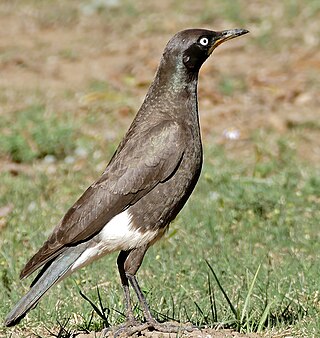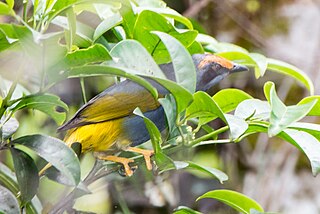
Starlings are small to medium-sized passerine birds in the family Sturnidae. The Sturnidae are named for the genus Sturnus, which in turn comes from the Latin word for starling, sturnus. The family contains 128 species which are divided into 36 genera. Many Asian species, particularly the larger ones, are called mynas, and many African species are known as glossy starlings because of their iridescent plumage. Starlings are native to Europe, Asia, and Africa, as well as northern Australia and the islands of the tropical Pacific. Several European and Asian species have been introduced to these areas, as well as North America, Hawaii, and New Zealand, where they generally compete for habitats with native birds and are considered to be invasive species. The starling species familiar to most people in Europe and North America is the common starling, and throughout much of Asia and the Pacific, the common myna is indeed common.

The mynas are a group of birds in the starling family (Sturnidae). This is a group of passerine birds which are native to Southern Asia, especially Afghanistan, India, Pakistan, Bangladesh, Nepal and Sri Lanka. Several species have been introduced to areas like North America, Australia, South Africa, Fiji and New Zealand, especially the common myna, which is often regarded as an invasive species.

The crested myna, also known as the Chinese starling, is a species of starling in the genus Acridotheres native to southeastern China and Indochina. It is named after the tuft of feathers on its forehead that resembles a crest.

The Javan myna, also known as the white-vented myna, is a species of myna. It is a member of the starling family. It is native to Bali and Java. It has been introduced to other Asian countries, and as far away as Puerto Rico.

Lamprotornis is a large genus of glossy-starlings all of which occur in Africa south of the Sahara. They have glossy blue or green upper parts, which is due to hollow melanin granules arranged in a single layer near the feather barbule's surface. This unique arrangement led to some glossy starlings formerly placed in the genus Spreo being transferred to Lamprotornis, since they shared this feature.

The pied starling or African pied starling is a bird endemic to South Africa, Lesotho and Eswatini. It is common in most of its range, but largely absent from the arid northwest and the eastern lowlands of South Africa. It is found in open habitats such as grassland, karoo scrub, thornbush and agricultural land, and often associates with farm animals.

The wattled starling is a nomadic resident bird in eastern and southern Africa. It is a species of grassland, open woodland, and cultivation.

The greater blue-eared starling or greater blue-eared glossy-starling is a bird that breeds from Senegal east to Ethiopia and south through eastern Africa to northeastern South Africa and Angola. It is a very common species of open woodland bird, and undertakes some seasonal migration.

The long-tailed starling is a species of starling in the family Sturnidae. It is endemic to the Schouten Islands off West Papua, in Indonesia, an important area of bird endemism. The species was once treated as part of a superspecies with the shining starling. There are two subspecies, the nominate race, which occurs on Biak, and brevicauda, which is found on Numfor Island. It occurs in a wide range of habitats at all altitudes, including natural forest and forest edges, as well as human modified secondary forests and gardens. In spite of its tiny global range the species is not considered threatened by human activities and remains common within its range, and is therefore listed as least concern by the IUCN.

The Sulawesi myna is a species of starling in the family Sturnidae. It is endemic to Sulawesi, Indonesia. Its natural habitat is subtropical or tropical moist lowland forests.

The Apo myna is a species of starling in the starling family Sturnidae. The species is also known as the Mount Apo starling or the Mount Apo king starling. It is the only member of the genus Goodfellowia. It is endemic to the Philippines found only in the tropical montane forests of Mindanao. It is threatened by habitat loss.

The fiery-browed starling or fiery-browed myna is a species of starling in the family Sturnidae. It is monotypic within the genus Enodes. Distinguished by a reddish-orange stripe over the eye, it is endemic to the Indonesian island of Sulawesi, mainly living in humid highland forest.

The narrow-tailed starling is a species of starling in the family Sturnidae. It is found in West and Central Africa from Sierra Leone to the Democratic Republic of the Congo.

The black-winged myna is a species of starling in the family Sturnidae. The species is also known as the black-winged starling or the white-breasted starling. It is endemic to Indonesia. There are three recognised subspecies: the nominate race, which occurs across much of the island of Java; tricolor, which is restricted to south east Java; and tertius, which is found on Bali and possibly Lombok. The validity of the records on Lombok has been called into question, as there are only a few records and those may represent escapees from the caged-bird trade or natural vagrants. The species has often been assigned to the starling genus Sturnus, but is now placed in Acridotheres because it is behaviourally and vocally closer to the birds in that genus.

The black-collared starling is a species of starling in the family Sturnidae. Its plumage is black and white, with a black collar. It is found in southern China and most of mainland Southeast Asia, and has been introduced to Taiwan, Malaysia and Singapore. Its habitats include grassland, dry forest and human settlements. The International Union for Conservation of Nature (IUCN) has assessed it as being of least concern.

The tiny sunbird is a species of bird in the family Nectariniidae. It is sparsely distributed across the African tropical rainforest.
The Enggano hill myna or Enggano myna is a member of the starling family. It is an endemic resident of Enggano Island, off southwest Sumatra. Clements lumps this species with the common hill myna.

The Nias hill myna or Nias myna is a member of the starling family. It is an endemic resident of Nias and other nearby islands off western Sumatra. Clements lumps this species with the common hill myna.

The long-tailed myna is a member of the starling family. It is native to the Bismarck and Solomon archipelagos. It resembles the yellow-faced myna, and the two were formerly considered conspecific.



















